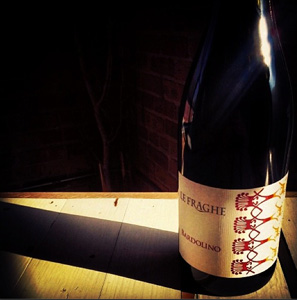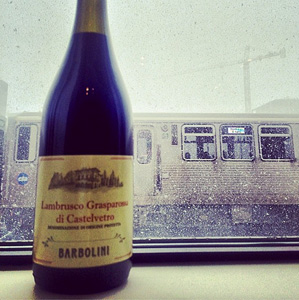| January 2014 | ||
| « Dec 2013 | News | Feb 2014 » |
January 31, 2014
FEATURED: There's gold in them there hills, and it's liquid.
In terms of wine, Alsace might as well be its own country. Geographically, it practically is—sandwiched between France and Germany; it is isolated from each by natural barriers (Vosges Mountains to the west and the Rhine River to the east). Though the region has certainly drawn inspiration from the two countries (both of which have laid claim to it over the centuries), its wines are like nothing else: opulent, exotic, terroir-driven whites with remarkable ability to age.
January 28, 2014
La Fraghe 2012 Bardolino DOC - Cream Import Spotlight
 It can’t be winter forever,* and so it’s time to start making plans: plans for sunshine and bathing suits and lakeside picnics. And while you’re at it, factor Bardolino into your dreams of warmer days. This light-bodied blend of Corvina and Rondinella hails from Verona in northern Italy, and is an absolute picnic slam dunk.
It can’t be winter forever,* and so it’s time to start making plans: plans for sunshine and bathing suits and lakeside picnics. And while you’re at it, factor Bardolino into your dreams of warmer days. This light-bodied blend of Corvina and Rondinella hails from Verona in northern Italy, and is an absolute picnic slam dunk.
Le Fraghe’s 2012 Bardolino is made in a 15th-century stone farmhouse by Matilde Poggi, who’s been producing wine under her own label since 1984. With Mount Baldo’s cooling influence to the north and Lake Garda’s uniquely Mediterranean climate to its west, her 69 acres of grapes develop an interesting complexity. Corvina is a highly structured grape that brings body and a distinct sour cherry quality to the mix. Rondinella is much softer, with low sugar levels and an ability to grow prolifically and resist disease. They are grown on 12-year-old vines that slope south to develop ripeness. The varietals are vinified separately, then blended. The blend goes through malolactic fermentation, then rests in stainless steel tanks until spring.
The result is a deep fuchsia in the glass, with complex notes of tar, rose, sour cherry, and a bit of menthol at the back of the palate. Served with a slight chill, the tannins provide structure and density to the mouthfeel. Charcuterie, olives, ahi tuna steak, salmon, anchovies, and feta cheese would all match up beautifully—anything you can fit in your picnic basket. Le Fraghe’s version of Bardolino is distinctive among this DOC for its layered earthiness, but it maintains all the fresh brightness you could ask for.
*Can it?
January 24, 2014
Serious Red Fizz
Emilia-Romagna may not be as famous as Venice for its canals (though it does have them) or as Florence for its art (there’s plenty of that, too), but it is home to some of the best food on the planet. Parmeggiano Reggiano, prosciutto di Parma, lasagne, tagliatelle al ragu, and tortellini were all invented in this region in central Italy. In balance to the richness of the cuisine, the wines have been traditionally light—and sometimes even lackluster. But, as Mae West would say, when they are good, they are very good. Barbolini’s Lambrusco is a stellar example of the region’s capability: a complex red sparkler with firm tannins and food friendliness.
 Barbolini is one of the stalwart Lambrusco makers in the region—they’ve been producing the fizzy stuff since 1889. It may be a playful wine, but they do not treat their Lambrusco lightly: they are certified organic, hand-harvesting, naturally fermenting zealots. They keep their yields low and employ cutting-edge methods and equipment, including soft pressing, thermo-controlled fermentation, and no irrigation. Their grapes come from the Grasparossa di Castelvetro DOC south of Modena, which is one of the smallest appellations, and one of Lambrusco’s most illustrious. Barbolini’s Lambrusco ‘Lancillotto’ is made entirely from a clone called Lambrusco Grasparossa grown on loose, sandy-clay, which produces dry, full-bodied, and food-friendly wines with ample tannins. Secondary fermentation happens via Charmat method, and the resulting bubbles show themselves in a deep purple froth.
Barbolini is one of the stalwart Lambrusco makers in the region—they’ve been producing the fizzy stuff since 1889. It may be a playful wine, but they do not treat their Lambrusco lightly: they are certified organic, hand-harvesting, naturally fermenting zealots. They keep their yields low and employ cutting-edge methods and equipment, including soft pressing, thermo-controlled fermentation, and no irrigation. Their grapes come from the Grasparossa di Castelvetro DOC south of Modena, which is one of the smallest appellations, and one of Lambrusco’s most illustrious. Barbolini’s Lambrusco ‘Lancillotto’ is made entirely from a clone called Lambrusco Grasparossa grown on loose, sandy-clay, which produces dry, full-bodied, and food-friendly wines with ample tannins. Secondary fermentation happens via Charmat method, and the resulting bubbles show themselves in a deep purple froth.
The wine is a brooding plum color, and the initial nose is very berried up front. It mellows into a more nuanced palate, maintaining the fresh berries, but settling into layers of dried lavender, minerality, and plum. It’s medium in weight, and finishes with firm tannins. Serve slightly chilled, and with a heaping plate of salami, mortadella, and prosciutto.
January 13, 2014
Overlooked Austria
Sometimes there’s an inverse relationship between the weather wine is grown in and the weather it’s suited for drinking in. Austria, a relatively cold, central European country with 62 percent of its landmass covered by Alps, makes wines that are so zippy and refreshing that you’ll want them by your side all summer long. Grapes are finicky creatures: they need enough sunlight to ripen and develop sugars, but if they ripen too fast, the wine will taste like Kool-aid. A cooler, slower, longer growing season allows the grapes to develop acidity as they ripen, and this translates to structure and backbone in wine.
With a host of indigenous grapes and a reputation for racing acidity, Austrian wine is food-friendly, unique, and, sadly, often overlooked. Despite its long vinous tradition dating back at least to the Celtic era, Austrian wine is still somewhat of an outlier on the American table. We are here to address this dearth with some beautiful, summer-friendly wines that are sophisticated, complex, and undeniably refreshing.
In Lower Austria, Emmerich Knoll is a leader in one of the country’s most famed wine regions, the Wachau. The estate has been run by the Knoll family for generations with the current man in charge being Emmerich Knoll III. He uses a decidedly gentle touch with his wines. He considers his wines late bloomers, and indeed some of them can age and drink well for up to 25 years. His Smargard wines from the Loienberg Vineyard are creamy, intense, and round, showing tobacco and exotic fruit flavors. This style of wine is among the longest lasting, most sophisticated that Austria has to offer. They are made only in years when there’s enough sunshine and conditions are extremely good. Knoll’s Federspiel wine serves as its light and refreshing counterpoint, with bone-dry acidity and delicate fruits. The Gruner Veltliner wine abounds with peaches and minerality, and is most definitely seafood-friendly.
Thirty minutes south of Vienna, in historic Thermenrgion, brothers Hannes, Christian, and Michael Reinisch (of J. Reinisch) are devoted to unique, indigenous varietals. The white Rotgipfler and Zierfandler grapes grown on their organic estate reflect a slowly dwindling regional tradition; there are only 247 acres of these grapes remaining across the country. Rotgipfler expresses both elegance and power with exotic fruits such as banana on the nose. It has vivacious acid and a long, vibrant finish. In addition to these white grapes, J. Reinisch produces beautiful and focused Pinot Noir, Zweigelt and St. Laurent.
When you’re sitting poolside this summer, or planning your next fish fry, think Austria. Let these exuberant wines cut through the summer heat and transport you to their mountainous homeland.
January 10, 2014
Coffee Lovers & Cocktail Lovers Unite
Firelit Coffee Liqueur is back!
 The coffee bean used for Batch 07 is Rwanda Mwasa from Blue Bottle Coffee Co. Blue Bottle’s founder, James Freeman, picked out the bean for this batch. Batch 07 is by far the darkest, richest and smoothest batch Firelit has released yet! It has a deep earthy coffee nose and intense blueberry notes. There was a lot of extra care and new technics implemented to get the very best intensity and flavor out of the beautiful Rwanda Mwasa beans, without straying from Firelits overall profile. Enjoy!
The coffee bean used for Batch 07 is Rwanda Mwasa from Blue Bottle Coffee Co. Blue Bottle’s founder, James Freeman, picked out the bean for this batch. Batch 07 is by far the darkest, richest and smoothest batch Firelit has released yet! It has a deep earthy coffee nose and intense blueberry notes. There was a lot of extra care and new technics implemented to get the very best intensity and flavor out of the beautiful Rwanda Mwasa beans, without straying from Firelits overall profile. Enjoy!
